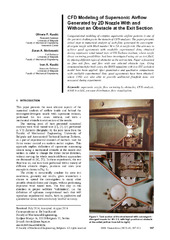Приказ основних података о документу
CFD modeliranje nadzvučne vazdušne struje generisane 2D mlaznikom sa preprekom i bez prepreke na izlazu
CFD modeling of supersonic airflow generated by 2D nozzle with and without an obstacle at the exit section
| dc.creator | Kostić, Olivera | |
| dc.creator | Stefanović, Zoran | |
| dc.creator | Kostić, Ivan | |
| dc.date.accessioned | 2022-09-19T17:41:54Z | |
| dc.date.available | 2022-09-19T17:41:54Z | |
| dc.date.issued | 2015 | |
| dc.identifier.issn | 1451-2092 | |
| dc.identifier.uri | https://machinery.mas.bg.ac.rs/handle/123456789/2149 | |
| dc.description.abstract | Modeliranje složenih nadzvučnih strujnih polja korišćenjem računara predstavlja jedan od najvećih izazova u oblasti CFD analiza. U radu su predstavljeni prvi koraci u numeričkoj analizi takvog strujanja, generisanog konvergentno- divergentnim mlaznikom sa Mahovim brojem M = 2.6 na izlazu iz mlaznika. Cilj je bio postići dobra poklapanja sa raspoloživim eksperimentalnim podacima, dobijenim tokom ispitivanja u nadzvučnom aerotunelu instituta VTI Žarkovo, gde su ispitivane mogućnosti vektorisanja potiska mlaznika sa vazduhom kao radnim fluidom, postavljanjem različitih tipova prepreka na izlazu iza mlaznika. U radu se analiziraju slučajevi strujanja sa slobodnim izlazom i sa jednim izabranim tipom prepreke na izlazu iz mlaznika. Za oba slučaja korišćene su strukturirane proračunske mreže za rešavanje RANS jednačina sa k-w SST turbulentnim modelom. Nakon kvalitativnih i kvantitativnih poređenja sa raspoloživim eksperimentalnim rezultatima, utvrđena su dobra poklapanja, pri čemu je CFD analiza bila u mogućnosti da pruži i dodatne podatke o strujnom polju, koji nisu mereni tokom eksperimenata. | sr |
| dc.description.abstract | Computational modeling of complex supersonic airflow patterns is one of the greatest challenges in the domain of CFD analyses. The paper presents initial steps in numerical analysis of such flow, generated by convergentdivergent nozzle with Mach number M = 2.6 at nozzle exit. The aim was to achieve good agreements with available experimental data, obtained during supersonic wind tunnel tests at VTI Žarkovo institute, where nozzle thrust vectoring possibilities had been investigated using air as test fluid, by placing different types of obstacles at the exit section. Paper is focussed on free exit flow, and flow with one selected obstacle type. Using structured mesh for both cases, the RANS equations with k-w SST turbulent model have been applied. After quantitative and qualitative comparisons with available experimental data, good agreements have been obtained, where CFD was also able to provide additional flowfield data, not measuted during experiments. | en |
| dc.publisher | Univerzitet u Beogradu - Mašinski fakultet, Beograd | |
| dc.rights | openAccess | |
| dc.rights.uri | https://creativecommons.org/licenses/by/4.0/ | |
| dc.source | FME Transactions | |
| dc.subject | supersonic nozzle | en |
| dc.subject | RANS k-w SST | en |
| dc.subject | pressure distribution | en |
| dc.subject | flow visualization | en |
| dc.subject | flow vectoring by obstacles | en |
| dc.subject | CFD analysis | en |
| dc.title | CFD modeliranje nadzvučne vazdušne struje generisane 2D mlaznikom sa preprekom i bez prepreke na izlazu | sr |
| dc.title | CFD modeling of supersonic airflow generated by 2D nozzle with and without an obstacle at the exit section | en |
| dc.type | article | |
| dc.rights.license | BY | |
| dc.citation.epage | 113 | |
| dc.citation.issue | 2 | |
| dc.citation.other | 43(2): 107-113 | |
| dc.citation.rank | M24 | |
| dc.citation.spage | 107 | |
| dc.citation.volume | 43 | |
| dc.identifier.doi | 10.5937/fmet1502107K | |
| dc.identifier.fulltext | http://machinery.mas.bg.ac.rs/bitstream/id/920/2146.pdf | |
| dc.identifier.scopus | 2-s2.0-84930718521 | |
| dc.type.version | publishedVersion |


